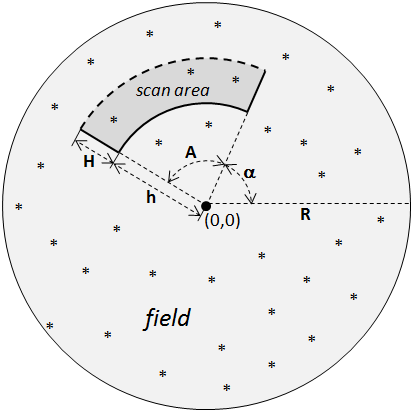Radars Inc. is a worldwide renowned radar maker, whose excellent reputation lies on strict quality assurance procedures
and a large variety of radar models that fit all budgets. The company hired you to develop a detailed inspection that consists
of a sequence of E experiments on a specific surveillance model.
There is a field represented with a polar coordinate plane that contains N objects placed at positions with integer
polar coordinates. The inspected model is located at the origin (0, 0) of the field and can detect objects at a distance less than
its detection range R through a scan area defined by four adjustment parameters  , A, h, and H, whose
meaning is illustrated with the following figure:
, A, h, and H, whose
meaning is illustrated with the following figure:
Formally, the scan area of the model is the region described by the set of polar points
 , A, h and H are four integer values where:
, A, h and H are four integer values where:
 specifies the start angle of the radar's scan area (
0
specifies the start angle of the radar's scan area (
0 
 < 360);
< 360);
- A specifies the opening angle of the radar's scan area (
0
 A < 360);
A < 360);
- h gives the internal radius of the radar's scan area (
0
 h < R); and
h < R); and
- H gives the height of the radar's scan area (
1
 H
H  R).
R).
An object placed at
(r, ) will be displayed by the model if
h
) will be displayed by the model if
h  r < h + H and
r < h + H and




 + A, where the last inequality should be understood modulo 360o (i.e., adding and
comparing angles in a circle).
+ A, where the last inequality should be understood modulo 360o (i.e., adding and
comparing angles in a circle).
Given N objects placed on the field, you must develop an inspection of the surveillance model through the implementation
of E experiments with specific parameterizations. For each experiment you have to find the maximal number of objects on the field
that the radar should display if the parameters  (
0
(
0 
 < 360) and h (
0
< 360) and h (
0  h < R) are free to set
(as integer numbers), and the parameters H (
1
h < R) are free to set
(as integer numbers), and the parameters H (
1  H
H  R) and A (
0
R) and A (
0  A < 360) are given.
A < 360) are given.
The input consists of several test cases. Each test case is described as follows:
- A line with two integer numbers N and R separated by blanks, representing (respectively) the number of objects located
on the field and the detection range of the model (
1
 N
N  104,
2
104,
2  R
R  102).
102).
- Each one of the following N lines contains two integer numbers ri and
 separated by blanks, specifying the
integer polar coordinates
(ri,
separated by blanks, specifying the
integer polar coordinates
(ri, ) of the i-th object (
1
) of the i-th object (
1  ri < R,
0
ri < R,
0 
 < 360,
1
< 360,
1  i
i  N).
N).
- The next line has an integer number E indicating the number of experiments of the inspection (
1
 E
E  102).
102).
- Each one of the following E lines contains two integer numbers Hj and Aj separated by blanks, representing (respectively)
the fixed height and the fixed opening angle that parameterize the j-th experiment
(
1
 Hj
Hj  R,
0
R,
0  Aj < 360,
1
Aj < 360,
1  j
j  E).
E).
For each test case you can suppose that there are not two different objects placed at the same integer polar coordinate.
The last test case is followed by a line containing two zeros.
For each test case of the input, print E lines where the j-th line contains the maximal number of objects on the
field that the radar should display according to the parameterization given for the j-th experiment (
1  j
j  E).
E).
6 100
15 7
15 60
40 15
50 15
45 30
45 90
2
2 1
100 359
9 100
15 7
15 60
40 15
50 15
45 30
45 90
40 45
50 45
78 100
6
100 359
11 30
10 30
11 29
5 30
11 10
0 0
1
6
9
5
3
3
2
2
